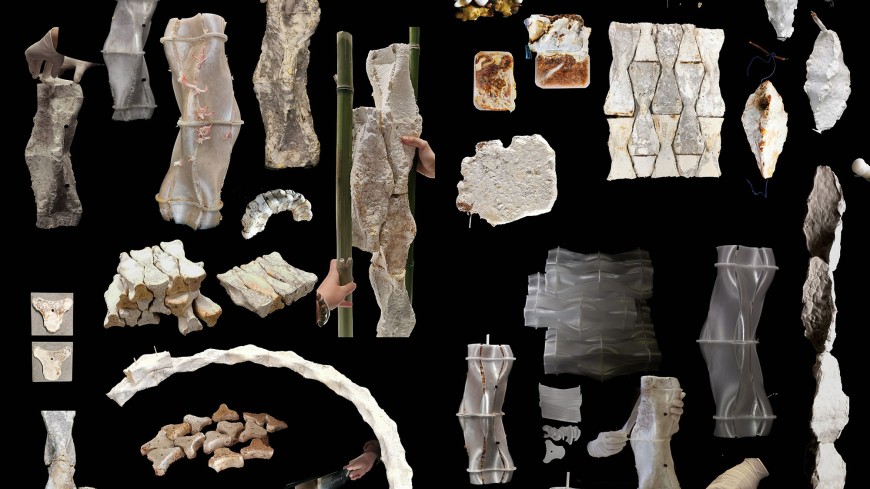Exhibition of the Master's theses
of the winter semester 2024/25 at the Department of Architecture
2025/01/28
From February 24 to 28, 2025, more than 60 graduates from the Department of Architecture at TU Darmstadt will present their final projects in the fields of building design and urban planning. The exhibition will be open to the public Monday to Friday throughout its duration.
The following topics were addressed:
Published by the Institute of Design and Building Construction (Prof. Felix Waechter)
On April 16, 2024, a devastating fire broke out in Børsen, one of Copenhagen’s oldest buildings, destroying not only its physical structure but also shaking the cultural identity of the city. However, the irreversible loss of three centuries of architectural heritage presents an opportunity—not just to rebuild the Børsen, but to redefine it as a social and cultural hub for dialogue and exchange.
As the “Hjemsted for Dansk Håndværk”—a home for Danish craftsmanship—this project seeks to revive the deep-rooted tradition of Danish craftsmanship, which has shaped the Børsen’s architectural history and remains a defining feature of Denmark’s built environment. The vision is to transform the Børsen into a dynamic showcase of Danish craftsmanship—one that not only preserves knowledge but also highlights the repair and evolution of architectural heritage.
Rather than simply reconstructing the Børsen as a historic monument, this reimagining positions it as a living part of urban life. It will serve as a space where the city’s history is reflected in all its dimensions—honoring its architectural past while integrating contemporary needs and challenges.
Exhibition Venue: Pabst Hall, 2nd Floor
Opening Hours: Mon–Fri, 8 AM–8 PM
The Darmstadt System – Disposal Building in Two Use Sections at the Lichtwiese Campus
Published by the Institute of Design and Sustainable Building (Prof. Christoph Kuhn)
A new train station is being planned in Bregenz, while elsewhere, stations are either deteriorating or being reduced in function. This presents a rare opportunity, which we aim to explore in this master’s thesis.
Railroads in the 19th century revolutionized travel and made train stations key urban landmarks. These “in-between spaces” serve as social hubs, playing a vital role in the urban fabric—both as prestigious landmarks and as social focal points. Today, smaller train stations, in particular, are losing their significance, turning into mere transit stops or commercial mobility hubs.
In Bregenz, we envision a countermodel: a new urban landmark, seamlessly integrating different modes of transport and connecting city districts between the historic center and the lake promenade. This project seeks to create an architectural space that celebrates and enhances the experience of travel and transition.
Exhibition Venue: Coop Hall (2nd Floor)
Opening Hours: Mon–Fri, 8 AM–8 PM
Productive (urban) quarter Gutleuthafen
Published by the Institute of Design and Urban Development (Prof. Dr. Annette Rudolph-Cleff)
“ÇA BOUGE EN VILLE – Architecture et Sport pour demain” was the title of an exhibition at Site Le Corbusier Firminy, as well as a parkour exhibition organized by the Institut français and its partner institutions in Stuttgart in the summer of 2024.
The question of the role of sports in the city of tomorrow undoubtedly calls for new answers. Sports bring people together—beyond commercialized offerings and across social and cultural boundaries. The image of Paris, which showcased its public spaces and the Seine as venues for the 2024 Olympic Games, demonstrated—beyond the media spectacle and political strategies of professional sports—that sports are no longer confined to stadiums and traditional sports facilities. Instead, they have become an integral part of urban daily life and can take place almost anywhere. Open spaces provide endless possibilities for how sports can shape and transform urban environments today and in the future.
New approaches are needed, as climate change and societal shifts pose significant challenges to the design of our urban and living spaces. Innovative solutions are required to create inclusive, multifunctional, and climate-resilient spaces. At the intersection of urban and landscape environments, sports and architecture open up diverse opportunities beyond consumption and commerce. Exploring and discovering, connecting and integrating—all of these are key aspects of sports, play, and architecture in the city.
The urban design master’s thesis for the winter semester 2024/25 focuses on the city of Neuss, posing the question: How can sports and architecture along the landscape corridor of the Erftaue create new, interconnected everyday spaces?
Exhibition Venue: Room 102 (Forum Young Researchers), 1st Floor
Opening Hours: Tentatively Mon–Thu 10 AM–6 PM, Fri 10 AM–2 PM
Freie Thesis betreut vom vom Fachgebiet Digitales Gestalten
Prof. Dr. Oliver Tessmann
In a mushroom farm, sawdust undergoes a sustainable cycle: first as a substrate for Ganoderma, then oyster mushrooms, and finally straw mushrooms, with nutrients fully utilized.However, in current mycelium-based material production, fungi are terminated once the mycelium fills the mold, preventing further cycles and resulting in waste. This project explores how mycelium can be sustainably integrated into architecture and daily life, highlighting its unique beauty. By designing an innovative topological interlocking geometry, the molds are applied in mushroom farming, and the leftover mycelium blocks are repurposed as temporary building materials, enabling a sustainable cycle between mushroom farming and mycelium-based architecture.
Ausstellungsort: Pabst-Saal (2. OG)
Öffnungszeiten: Mo.–Fr., 8–20 Uhr
Information
Exhibition Duration:
Monday, February 24 – Friday, February 28, 2025
Department of Architecture
Building L3|01
El-Lissitzky-Straße 1
64287 Darmstadt
Ceremonial Farewell for Graduates
Friday, February 21, 2025, at 4:00 PM
Max-Guther Lecture Hall (L3|01 Room 93)
El-Lissitzky-Straße 1
Campus Lichtwiese, TU Darmstadt
Keynote Speech by Max Otto Zitzelsberger (Architect, Munich/Kneiting)








